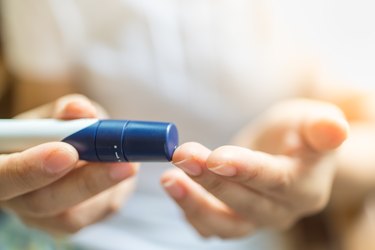
If you have diabetes, it's important to try to keep your glucose, or blood sugar, levels within your target range. If your blood sugar either dips too low or spikes too high, you could experience serious health complications — both in the short and long term, according to the American Diabetes Association (ADA).
One of the primary ways you can keep tabs on your blood sugar levels is with blood glucose monitoring, either with a blood glucose meter or a continuous glucose monitor (CGM).
Video of the Day
Video of the Day
Talk to your doctor or health care provider about what your target blood sugar levels might be. In the meantime, here are some tips to identify if your blood sugar is too high or too low and what to do if you have dangerous blood sugar levels.
What Are Target Blood Sugar Levels?
While your target blood sugar levels may be different from another person's, the ADA tells most (non-pregnant) adults with diabetes to shoot for a blood glucose level of 80 to 130 milligrams per deciliter (mg/dL) before a meal and less than 180 mg/dL one to two hours after a meal.
Doctors can also measure your average blood sugar levels with an A1C test, which can give you an idea of how high or low your glucose levels have been over the past few months. Most people with diabetes will want to keep their A1C levels to less than 7 percent, according to the ADA.
Hypoglycemia
Called hypoglycemia, low blood sugar levels have fallen far enough that you need to take steps to bring them back up again, according to the ADA. The organization points out that, in general, this is when your blood sugar has fallen below 70 mg/dL, though that number can vary from person to person depending on their age, health and more. The lower your blood sugar falls, the more serious the situation can be.
Some of the symptoms of low blood sugar include:
- shakiness
- confusion
- rapid heartbeat
- nausea
If you have some of these symptoms, or believe your blood sugar is low, start by checking your meter to confirm. If your blood sugar levels are indeed low, eat something containing about 15 to 20 grams of carbohydrates. Try 4 to 5 ounces of juice, regular sweetened soda, a tablespoon of honey or a small packet of raisins. Avoid eating carbs that also contain protein or fat (such as a chocolate bar), as they can slow down the absorption of the carbs. Then, wait about 15 minutes for your blood sugar to rise, and check your levels again with your meter. If you're not above your goal (70 mg/dL), eat a little more.
Try to treat low blood sugar levels by eating some carbohydrates quickly, says Susan Spratt, MD, an endocrinologist and professor of medicine at the Duke University School of Medicine. "If you are driving and your blood sugar drops too low, you need to pull off to the side of the road and treat it immediately," she says.
Low blood sugar levels can be caused by too much insulin (for example, accidentally injecting too much insulin medication), not eating enough carbohydrates, exercising too long or too intensely and other factors. If your levels remain low for too long, you can cut off the glucose supply to the brain, possibly leading to a seizure, coma or (rarely) death, according to the ADA.
Hyperglycemia
Hyperglycemia, or high blood sugar, is characterized by too much glucose in the blood. According to the ADA, some of the symptoms of high blood sugar include:
- frequent urination
- increased thirst
- blurry vision
The ADA lists not taking enough diabetes medication (such as insulin or pills), eating more than you planned or becoming sick with a cold, flu or other illness as some of the potential causes of high blood sugar levels.
If glucose is mildly elevated (above 180 mg/dL), taking a walk and drinking more water will help bring it down (as well as help you stay hydrated). If your levels stay above 250 mg/dL, call your doctor for instructions, as you may need to take additional diabetes medicine.
If left untreated, hyperglycemia can lead to damage to blood vessels or nerves. This damage, in turn, can cause complications such as eye diseases, kidney problems and the need for amputation.
For people with type 1 diabetes, it can also lead to diabetic ketoacidosis, a serious condition that occurs when your body can no longer burn glucose for energy and starts breaking down fats instead. If you have type 1 diabetes and your glucose levels rise above 250 mg/dL, it's important to check for the presence of chemicals called ketones in your body with a urine or a blood test and contact your doctor if you test positive.
Read more: How to Lower Blood Sugar Levels Fast
- American Diabetes Association: "Complications"
- American Diabetes Association: "The Big Picture: Checking Your Blood Glucose"
- American Diabetes Association: "Understanding A1C: A1C does it all."
- American Diabetes Association: "Hypoglycemia (Low Blood sugar)"
- American Diabetes Association: "Hyperglycemia (High Blood Glucose)"
- American Diabetes Association
Was this article helpful?
150 Characters Max
0/150
Thank you for sharing!
Thank you for your feedback!
Is this an emergency? If you are experiencing serious medical symptoms, please see the National Library of Medicine’s list of signs you need emergency medical attention or call 911.